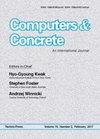Numerical analysis of simply supported one-way reinforcedconcrete slabs under fire condition
IF 2.9
4区 工程技术
Q2 COMPUTER SCIENCE, INTERDISCIPLINARY APPLICATIONS
引用次数: 4
Abstract
This paper investigates the mechanical response of simply supported one-way reinforced concrete slabs under fire through numerical analysis. The numerical model is constructed using the software ABAQUS, and verified by experimental results. Generally, mechanical response of the slab can be divided into four stages, accompanied with drastic stress redistribution. In the first stage, the bottom of the slab is under tension and the top is under compression. In the second stage, stress at bottom of the slab becomes compression due to thermal expansion, with the tension zone at the mid-span section moving up along the thickness of the slab. In the third stage, compression stress at bottom of the slab starts to decrease with the deflection of the slab increasing significantly. In the fourth stage, the bottom of the slab is under tension again, eventually leading to cracking of the slab. Parametric studies were further performed to investigate the effects of load ratio, thickness of protective layer, width-span ratio and slab thickness on the performance of the slab. Results show that increasing the thickness of the slab or reducing the load ratio can significantly postpone the time that deflection of the slab reaches span/20 under fire. It is also worth noting that slabs with the span ratio of 1:1 reached a deflection of span/20 22 min less than those of 1:3. The thickness of protective layer has little effect on performance of the slab until it reaches a deflection of span/20, but its effect becomes obvious in the late stages of fire.火灾条件下单向简支钢筋混凝土板的数值分析
本文通过数值分析研究了单向简支钢筋混凝土板在火灾作用下的力学响应。利用ABAQUS软件建立了数值模型,并通过实验结果进行了验证。一般情况下,楼板的力学响应可分为四个阶段,并伴有剧烈的应力重分布。在第一阶段,楼板底部受拉,顶部受压。在第二阶段,楼板底部应力因热膨胀而变为压缩,跨中截面的拉张区沿楼板厚度向上移动。在第三阶段,随着板坯挠度的显著增大,板坯底部压应力开始减小。在第四阶段,楼板底部再次受拉,最终导致楼板开裂。进一步进行了参数化研究,探讨了荷载比、保护层厚度、宽跨比和板厚对板性能的影响。结果表明,增加楼板厚度或减小荷载比可显著延缓楼板在火灾作用下挠度达到跨度/20的时间。同样值得注意的是,当跨度比为1:1时,楼板的挠度比为1:3时的楼板挠度要小20 ~ 22分钟。保护层厚度对板的性能影响很小,直到其挠度达到跨度/20,但其影响在火灾后期变得明显。
本文章由计算机程序翻译,如有差异,请以英文原文为准。
求助全文
约1分钟内获得全文
求助全文
来源期刊

Computers and Concrete
工程技术-材料科学:表征与测试
CiteScore
8.60
自引率
7.30%
发文量
0
审稿时长
13.5 months
期刊介绍:
Computers and Concrete is An International Journal that focuses on the computer applications in be considered suitable for publication in the journal.
The journal covers the topics related to computational mechanics of concrete and modeling of concrete structures including
plasticity
fracture mechanics
creep
thermo-mechanics
dynamic effects
reliability and safety concepts
automated design procedures
stochastic mechanics
performance under extreme conditions.
 求助内容:
求助内容: 应助结果提醒方式:
应助结果提醒方式:


